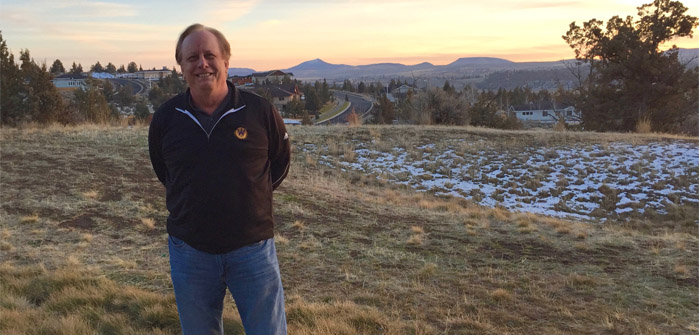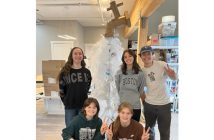(Jim Weyermann standing on the grounds of the MAC with Bean Foundation land in the background | Photo by Bill Mintiens)
Sustainability and youth health.
On the heels of an $8.1M bond in 2004, in 2006 Madras created a recreation district. In 2008 the beautiful Madras Aquatic Center (MAC) opened — but soon after experienced financial problems. Why? There was no maintenance fund for basic operations.
Feeling burned and sliding into the Great Recession, voters rejected the first levy to fund operations. By 2011 the MAC was forced into temporary shut downs, the result of a $90K budget shortfall.
Residents were convinced that government officials had no idea how to profitably operate the beautiful new facility.
It wasn’t until 2013, with the recession receding, that voter confidence allowed a new five-year operating levy to pass. The MAC was more or less stable financially — because tax payers (read families) believed in the value of recreational opportunities for the community’s youth.
But there was another problem. Top management turnover at the MAC. Seven executive directors in ten years. And last summer the sixth executive director, who had been named “Outstanding Director of the Year” for 2017 by the Madras-Jefferson County Chamber of Commerce, was fired under a cloud of controversy.
Some would argue that those who held the position really didn’t have the background or skills to make the MAC…..wait for it…..sustainable.
Enter the Visionary
One of those critics is the new executive director, Jim Weyermann, hired last October to crack the paradigm about what the Madras Recreation District could be as it recovers from the pain of the early MAC years.
“I think what you’ll find is that, for Madras, that passion (youth sports, recreation) hasn’t changed, it’s just gotten old,” said Weyermann. “It’s been talked about so much, with so many stops and starts, nobody knew what to do, how to sustain it.”
And then he threw in the reminder about why recreation districts exist and how to fund them.
“A recreation district’s heart and soul is accessibility – to anyone,” said Weyermann. “Our mission is to those kids that are disconnected from the mainstream opportunities — and pay for it with the people who want to compete by selling your facilities.”
Ah……the definition of sustainability for a recreation district. But you need state-of-art facilities to attract the competitive sports world.
The Answer
Back on December 19, 2018 the Madras Pioneer reported that Weyermann, just a couple of months on the job, was proposing a huge sports complex that would be built without tax payer money. A 125,232-square-foot indoor complex would accommodate soccer, basketball, volleyball and badminton tournaments. There would also be an open weight room, wellness center for rehabilitation, an indoor ice skating rink and ample storage facilities.
All on about 20 acres of the 70-acre Juniper Hills Park close to the MAC.
Estimated cost — $30-40M. And did I mention — not a dime from tax payers? A private donor with a desire to build a sports complex in Madras was the proposed funding source.
Fast forward to my interview with Weyermann early January 2019 — and it turns out the “answer” has grown in scope.
“The old model was 20 acres in Juniper Hills at $30-40M,” explained Weyermann. “The new model that we’re looking at now is about four times that size, redeveloping all the land that the county owns in Juniper Hills — and perhaps $80M.”
A Visionary or a Shyster?
Having lived and worked throughout Central Oregon since 1992, I’ve seen my share of shady start-ups and “entrepreneurs” come and go. Struggling organizations reach out to an “industry expert” (or savior) to come in and straighten out the ship — only to find that the person doesn’t understand the culture of either the organization or the region.
So during my drive to Madras I struggled with the preconceived notion that Weyermann was just another shyster duping the people of Madras.
In our interview he acknowledged that his energetic visionary approach scares some people. “I think some people look at me and think I escaped from a mental institution and, because everyone is so nice here, they just listen and won’t say anything.”
Turns out my preconceived notion was dead wrong, his background and accomplishments blew me away.
The Evolution of a Visionary
Originally from North Carolina and Missouri, Weyermann’s father was a minister in St. Louis. Jim took to heart one of the central lessons imparted by his father.
“It doesn’t matter what profession you choose in life — what matters is that the world is a better place for you having been in it,” said Jim. “The way you evaluate that is how you were able to positively impact the people you live in this world with.”
For Jim this meant taking a lifelong love of recreation and sports, mixing it with fortuitous career opportunities and a “we can do this” visionary approach to challenges.
“To me that (message from Dad) developed a sense in terms of facilities,” recalled Weyermann. “I’ve been involved in 4-5 major development projects with cities and sports facilities.”
The challenge of an 80-acre sustainable sports complex in Madras Oregon fit right into Weyermann’s wheelhouse. He’d already done it.
Street Cred
Weyermann spent twelve years as Deputy Director of the Seattle Center, site of the 1962 Seattle World’s Fair, where he managed the marketing, sales and event management of the 28 facilities on the grounds — the Space Needle and the SuperSonics to name just two.
As a member of the Seattle Sports Council for 12 years, Weyermann did the bidding for the city for the Final Four, USA Gymnastics, and other national sports organizations.
“That’s where I learned how to do just about anything from an event standpoint and how facilities work,” said Weyermann.
A defining moment in Weyermann’s visionary philosophy came as a result of a phone call from Seattle’s Mayor, Norm Rice. He wanted Jim’s ideas on how to raise $250K, which wasn’t in the general fund, to fill pot holes.
Jim said that, if the Mayor could clear it with the police chief and allow four shows of The Grateful Dead in downtown Seattle, the 5% admissions tax would raise $300K all by itself. The concerts took place and the pot holes were fixed.
“This characterized my life,” said Jim. “I see a need and figure out how to do it, regardless of those who say it can never be done.”
The rest of Weyermann’s resume would make a wonderful episode on ESPN’s 30 for 30 documentary series. He worked for Microsoft co-founder, Paul Allen, in the development and launch of The Experience Music Project (now called the Museum of Pop Culture) within the Seattle Center complex.
He served two years with the Positive Coaching Alliance at Stanford University, a national non-profit with a mission to transform the culture of youth sports so that young athletes can have a positive, character-building experience. Phil Jackson, former Los Angeles Lakers head coach, became the spokesperson.
He spent seven years with the San Jose Giants, the farm club for San Francisco Giants. As President of the club, Jim was tasked with increasing attendance and revenue. In 2009 the club won the President’s trophy for the single best-operated franchise in minor league baseball (out of 162 teams).
“People ask so how did you do it?” said Jim. “You do it by delivering on the brand promise. In minor league sports it’s fun, affordable family entertainment.” Understanding the “brand promise” would also be central to Weyermann’s promotion of the proposed Madras sports complex.
And then the Golden State Warriors called. Jim was recruited by Joe Lacob, co-owner, to replicate what he did for the San Jose Giants — for the Warriors farm club. It was a perfect challenge for Weyermann — and one that would influence his thinking years later in Madras.
Weyermann wanted to move the farm club, The Dakota Wizards, from Bismarck North Dakota to Santa Cruz California. The NBA commissioner hated the idea of a minor league team in Santa Cruz, didn’t think it fit their demographic profile for a farm team.
With the backing and support of Joe Lacob, Weyermann moved the club to Santa Cruz. With no spectator stadium in Santa Cruz, Weyermann had one built in less than a year, in time for the Santa Cruz Wizards to start their 2012-13 season.
“Naysayers, in February, said that it couldn’t be done in time for the season to open in December. I said that didn’t mean we can’t do it,” said Weyermann. “We built the building in 68 days.”
Delivering on the Brand Promise in Madras Oregon
Weyermann firmly believes that the “brand promise” in Madras was clear even before he arrived. Families wanted the MAC, even funded it after suffering shut downs and financial challenges. They’ve shown that recreational and sports facilities are important to them.
And, given his street cred, he knew that by creating a blueprint for sustainability he could promote healthy lifestyles and family friendly activities.
“We’re losing the health battle (obesity, inactivity) with our youth and here’s how we can fix it,” said Weyermann. “A proposal like this (a huge sports complex) is in the wheelhouse of our families — giving the family an opportunity to enjoy each other in an outdoor environment.”
Sustainability — Competitive Youth Sports
Weyermann firmly believes there aren’t enough sports and recreation facilities — thus the proposal for a huge sports complex. “The one thing I know for certain is that there are not enough athletic facilities for the demand – period,” he said. “The colleges and school districts are so pushed for demand that they simply can’t accommodate everyone.”
He also believes that the competitive youth sports tournament market is the commercial revenue-generating activity that will ensure the necessary sustainability. Citing national statistics Weyermann said “Youth sports have grown from $7B this year to an estimated $15B next year. For comparison the NFL (National Football League) is $14B.”
But the central question becomes — can you attract enough competitive commercial activity to Madras in order to ensure sustainability? “I can’t guarantee it but everything tells me it’s doable because we’re already driving outside of the market,” said Weyermann. “Look at our swim team, one of the best in the area, it was just in Los Angeles and San Diego competing.”
Weyermann’s qualifier — “We’ll draw teams from other parts of the country IF our complex and facilities are second-to-none.”
The Donor
A chance meeting last fall brought Weyermann into contact with the mysterious donor. Trying to bait Weyermann into giving me a name I told him that it must be Nike co-founder Phil Knight.
“Nope, he’s a Madras resident and a very accomplished athlete, sports changed his life and mine,” said Weyermann. “We understand the power of sports and that we’re losing the battle on a number of fronts (obesity, drugs, screen time). We both have a passion for youth sports and reaching those kids that are disconnected.”
Waxing philosophically about the donor, Weyermann said, “There is always someone within a city, big or small, who can change the destiny of that city singlehandedly.”
Project Timeline
Forging ahead, Weyermann is quick to point out that planning on this scale can change on a day to day basis as new information comes to light.
“I’m expecting to have a design funded by the end of January 2019,” he said. After that we’ll assign a design team and pick a general contractor.”
Never wanting an operational funding challenge again, Weyermann is certain about one thing, however, the management of the new facilities. “We’re going to hire an outside, for-profit company to come in and operate these facilities.”
Project Update
Jim Weyermann, in a phone conversation January 28, 2019, indicated that they have “slowed down the process.” The initial funding has been delayed and the mysterious donor is now a “developing partner” who will be working with The Bean Foundation, the Madras nonprofit organization that owns both the bare land and developed lots on which a large sports complex could be built.





